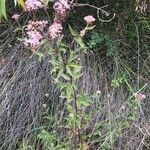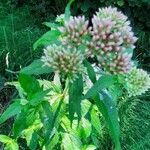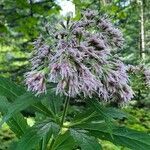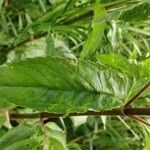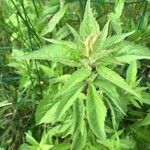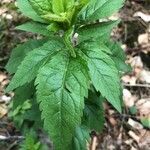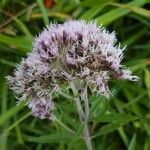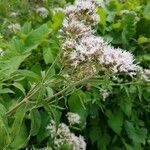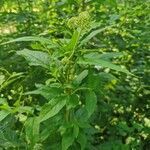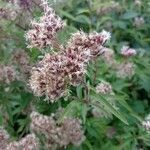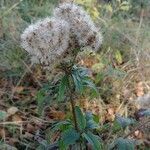Herbs, perennial, 50-150 cm tall. Rhizomes robust, with many fibrous roots. Stems erect, purplish red, simple or only apically corymbose branched, puberulent; synflorescence branches and peduncles more densely hairy, glabrescent in median lower part by anthesis. Leaves opposite, shortly petiolate; petiole ca. 5 mm; median and lower leaves irregularly lobed; central lobe elliptic or narrowly lanceolate, large, 6-11 × 2-3 cm, base cuneate or broadly cuneate, apex acuminate or long acuminate; lateral lobes same shape as central lobe, smaller; upper stem leaves gradually smaller, irregularly lobed or simple; lower stem leaves shed by anthesis; all stem leaves scabrid, rather thick, sparsely puberulent and glandular, more densely hairy abaxially and on veins, pinnately veined, lateral veins 5-or 6-paired, margin serrate, undulate. Synflorescences terminal, of densely compound corymbs. Capitula numerous, 3-7-flowered; involucre campanulate, ca. 6 mm; phyllaries 2-or 3-seriate, imbricate; outer phyllaries short, ovate-lanceolate, ca. 2 mm, puberulent; median and inner phyllaries gradually longer, with membranous margin and purplish tip; corollas purple-red, pink, or whitish, ca. 5 mm, outside sparsely yellow glandular. Achenes black-brown, cylindric, ca. 3 mm, 5-ribbed, with yellow glands; pappus setae white, ca. 5 mm. 2n = 20.
More
Perennials, 30–150 cm. Stems (from short rhizomes) single, branched distally, puberulent. Leaves opposite; subsessile or petiolate; blades palmately 3(–5)-lobed (at least larger proximal, lobes relatively broad), blades (or lobes) lanceolate to lance-ovate, 50–100 × 20–40 mm, margins serrate, apices rounded to acute, faces puberulent, gland-dotted. Heads in dense, corymbiform arrays. Phyllaries 8–10 in 2–3 series, oblong, 4.5–6 × 1.5–2 mm, apices rounded, abaxial faces puberulent, gland-dotted. Florets (4–)5(–6); corollas (usually pinkish) 2–2.5 mm. Cypselae 2–3 mm; pappi of 20–30 bristles 3–5 mm. 2n = 20.
A herb. It keeps growing from year to year. It grows 50-150 cm tall. It has robust rhizomes. The stems are erect and purplish red. The leaves are opposite. The lower leaves have irregular lobes. The leaves are 6-11 cm long by 2-3 cm wide. The leaves get smaller up the stem.
A gregarious plant of marshes and fens, streambanks and moist woods. By streams, in low damp sites and in woods, avoiding acid soils.
More
It is a temperate plant. In China it grows on the top of small hills and among bamboos
